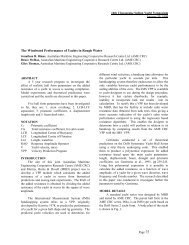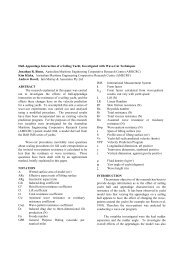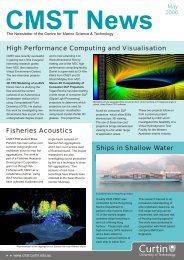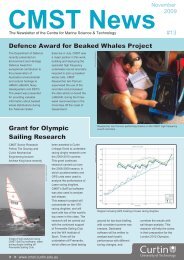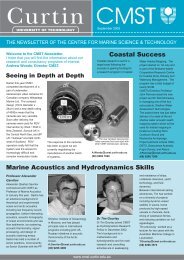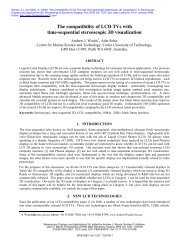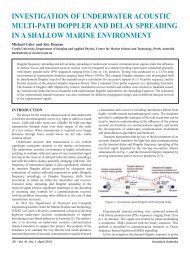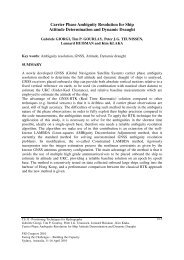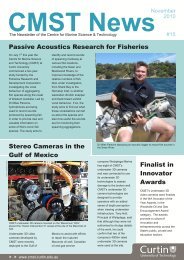Blue whale calling in the Rottnest trench-2000, Western ... - ANP
Blue whale calling in the Rottnest trench-2000, Western ... - ANP
Blue whale calling in the Rottnest trench-2000, Western ... - ANP
You also want an ePaper? Increase the reach of your titles
YUMPU automatically turns print PDFs into web optimized ePapers that Google loves.
These calls were only heard <strong>in</strong> this record<strong>in</strong>g session, and not aga<strong>in</strong> <strong>in</strong> any of <strong>the</strong> drift<strong>in</strong>g<br />
sequences or from <strong>the</strong> bluey logger set. The gear was deployed near to a school of approximately<br />
35 Rissos dolph<strong>in</strong>s (Grampus griseus) but given <strong>the</strong> low frequency nature of <strong>the</strong> calls it was<br />
unlikely to have orig<strong>in</strong>ated from <strong>the</strong>se animals.<br />
3.6.4) Four second 'chirps'<br />
At <strong>the</strong> time of f<strong>in</strong>alis<strong>in</strong>g this report a scaled down series of field trials was be<strong>in</strong>g carried out<br />
(summer 2001). A set of drift<strong>in</strong>g records picked up a series of high level four second 'chirps', not<br />
seen before. <strong>Blue</strong> <strong>whale</strong>s had been sighted <strong>the</strong> previous day and were sighted several days later,<br />
but not on <strong>the</strong> day of record<strong>in</strong>g. These record<strong>in</strong>gs had high flow noise as <strong>the</strong>y were taken from a<br />
drift<strong>in</strong>g d<strong>in</strong>ghy. An example of this call type is shown on Figure 36.<br />
Figure 36: 'Chirps' recorded from drift<strong>in</strong>g set <strong>in</strong> early 2001.<br />
3.6.5) Dolph<strong>in</strong> signals<br />
A large proportion of <strong>the</strong> drift<strong>in</strong>g record<strong>in</strong>gs conta<strong>in</strong>ed dolph<strong>in</strong> whistles and echolocation<br />
signals. It is probable that <strong>the</strong> bluey logger set also had dolph<strong>in</strong> signals <strong>in</strong> it, but <strong>the</strong>se were not<br />
looked for and as <strong>the</strong>y were removed <strong>in</strong> <strong>the</strong> down-sampl<strong>in</strong>g process of <strong>the</strong> blue <strong>whale</strong> analysis,<br />
would not have been apparent <strong>in</strong> <strong>the</strong> search<strong>in</strong>g that was carried out. Several species of sp<strong>in</strong>ner<br />
(Stenella spp.) and <strong>the</strong> bottlenose dolph<strong>in</strong> (Tursiops truncatus) were sighted <strong>in</strong> <strong>the</strong> boat surveys.<br />
3.7) <strong>Blue</strong> <strong>whale</strong> call search techniques<br />
Given <strong>the</strong> precise tonal character of <strong>the</strong> calls <strong>the</strong>n <strong>the</strong> possibility of us<strong>in</strong>g spectrogram cross<br />
correlation techniques, as described by Mell<strong>in</strong>ger and Clark (<strong>2000</strong>) for bowhead calls, to<br />
automate call identification seemed attractive. The 4827 records from <strong>the</strong> bluey record<strong>in</strong>g set<br />
presented an enormous and time consum<strong>in</strong>g data set to search for blue <strong>whale</strong> calls. Two o<strong>the</strong>r<br />
sets of <strong>the</strong> bluey logger are also available for search<strong>in</strong>g for blue <strong>whale</strong> calls, 2955 records from<br />
off Cape Leeuw<strong>in</strong> <strong>in</strong> 1998, and 5069 records from off Exmouth <strong>in</strong> <strong>2000</strong> (with confirmed blue<br />
<strong>whale</strong> <strong>call<strong>in</strong>g</strong> <strong>in</strong>). Automatic identification would allow <strong>the</strong> accurate placement of components<br />
with<strong>in</strong> a record, and thus allow calculation of each component level, a requirement for <strong>the</strong><br />
acoustic census<strong>in</strong>g technique us<strong>in</strong>g a s<strong>in</strong>gle hydrophone.<br />
Spectrogram correlation techniques were thus developed us<strong>in</strong>g high SNR ratio components to set<br />
up kernels, or reference spectrogram signals conta<strong>in</strong><strong>in</strong>g <strong>the</strong> component structure to be searched<br />
for, and correlat<strong>in</strong>g <strong>the</strong>se aga<strong>in</strong>st measured spectrograms. The standard correlation technique<br />
multiplied <strong>the</strong> kernel aga<strong>in</strong>st <strong>the</strong> test section <strong>the</strong>n summed <strong>the</strong> result to give a s<strong>in</strong>gle value for<br />
34



